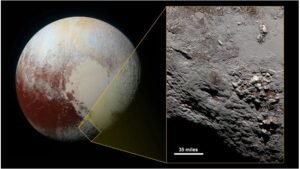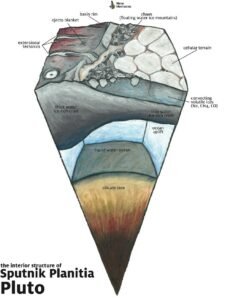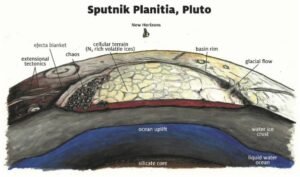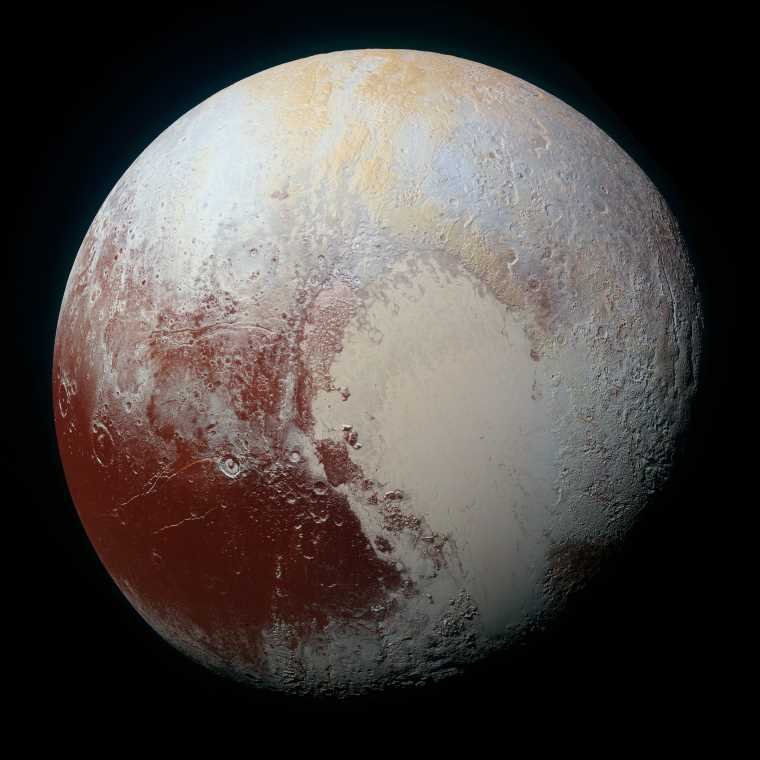A new study by researchers from Washington University in St Louis supports the relatively recent theory that a liquid water ocean lies beneath the icy surface of the dwarf planet Pluto. Previously, scientists thought Pluto was simply too cold to support liquid water, but more recent findings seemed to indicate Pluto had a liquid water ocean after all.
This new study not only supports that idea but also offers a compelling case for a planet-wide ocean with a composition similar to that of the Great Salt Lake in Utah.
Clues to Ocean beneath Pluto Revealed By a Billion-Year-Old Comet Strike
When NASA’s New Horizons spacecraft was launched in 2006, most astronomers believed that Pluto was too cold to support liquid water even beneath its vast icy shell. That same year, a review of new understandings of the space bodies orbiting the sun led to Pluto’s demotion from a planet to a dwarf planet.
“Pluto is a small body,” said Alex Nguyen, a graduate student in earth, environmental, and planetary sciences in Arts & Sciences at Washington University in St. Louis and the lead author of the new study. “It should have lost almost all of its heat shortly after it was formed, so basic calculations would suggest that it’s frozen solid to its core.”
So, when New Horizons finally entered the dwarf planet’s orbit in 2015, researchers were shocked to discover it was more geologically active than previously believed. For example, images of what appeared to be a pair of large cryovolcanoes spewing water vapor into space were spotted on the surface, reigniting the liquid water debates. The spacecraft also spotted cracks in the same area, dubbed Sputnik Plantia, where a comet had slammed into Pluto over a billion years earlier, which seemed to reveal relatively recent geological activity.


After those stunning findings, scientists began to reassess Pluto, including the idea that a massive ocean of liquid water could exist under its surface. Now, Nguyen and study co-author Patrick McGovern of the Lunar and Planetary Institute in Houston say their analysis of the New Horizon’s data combined with new computer modeling makes the most compelling case for a liquid ocean on Pluto yet.
New Calculations Add Support to Liquid Water Ocean Theory
In the new research published in the journal Icarus, Nguyen and McGovern employed complex computer simulation tools that could help analyze the data from New Horizons. Specifically, they wanted to model the cracks and bulges seen on the surface of Sputnik Planitia to determine if they were being created by liquid water ice beneath the surface. They also hoped their models would reveal clues about the ocean’s composition, particularly its salinity.
After plugging in the data from New Horizons and data collected by other studies of Pluto, the team says they made two major findings. First, their models seem to confirm that there is an ocean there after all.
“It’s now generally accepted that Pluto has an ocean,” Nguyen said.
Second, the team found that a portion of that ocean beneath Sputnik Planitia lies under 40 to 80 km of ice and is likely denser than Earth’s oceans. That’s because the cracks in the crater’s floor are just the right size to support an ocean that is roughly 8% denser than our oceans.


“If the ocean was significantly less dense, the ice shell would collapse, creating many more fractures than actually observed,” the press release announcing the study explains. “If the ocean was much denser, there would be fewer fractures.”
“We estimated a sort of Goldilocks zone where the density and shell thickness is just right,” Ngyuen added.
For comparison, the researchers said that this lake has roughly the same density and, therefore, salinity as the Great Salt Lake.


A Potential Candidate for the Search for Life Beyond Earth
While there are no future missions to explore Pluto currently in the works, the presence of a subsurface ocean would add it to the growing list of targets for astrobiologists hunting for signs of life beyond Earth. Currently, Jupiter’s moon Europa and Saturn’s moon Enceladus are among the top targets on that list, as they also appear to have subsurface oceans of liquid water, which are potentially capable of supporting life as we know it.
Although there are no current plans to explore those targets either, The Debrief recently covered one mission idea that includes a snake-like robot that can crawl down through the cracks in the surface of Enceladus to begin the hunt. Researchers have also proposed flying a spacecraft through the plumes of water ejected by Europa and Enceladus with hopes of capturing any biological material that could confirm their oceans have life.
Moving forward, the researchers say they hope future missions will not only confirm the presence of Pluto’s ocean but also add even more detail to its composition. The team also thinks that recent findings about Pluto, including two new moons discovered by New Horizons, may also reopen the question of whether or not the 2006 demotion to dwarf planet status was a correct one.
“From my perspective, it’s a planet,” said Nguyen.
Christopher Plain is a Science Fiction and Fantasy novelist and Head Science Writer at The Debrief. Follow and connect with him on X, learn about his books at plainfiction.com, or email him directly at christopher@thedebrief.org.

